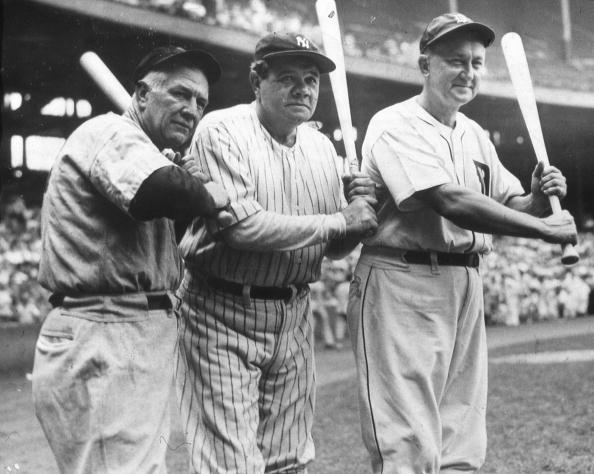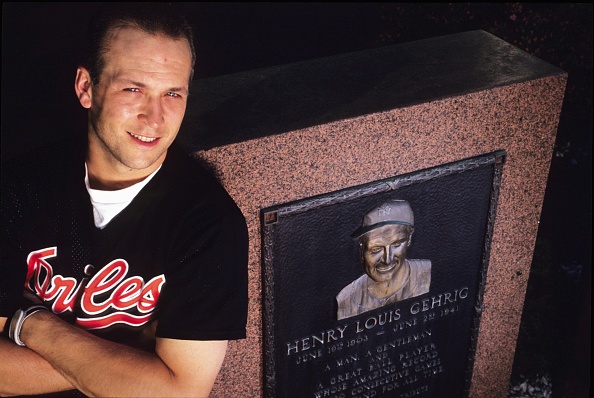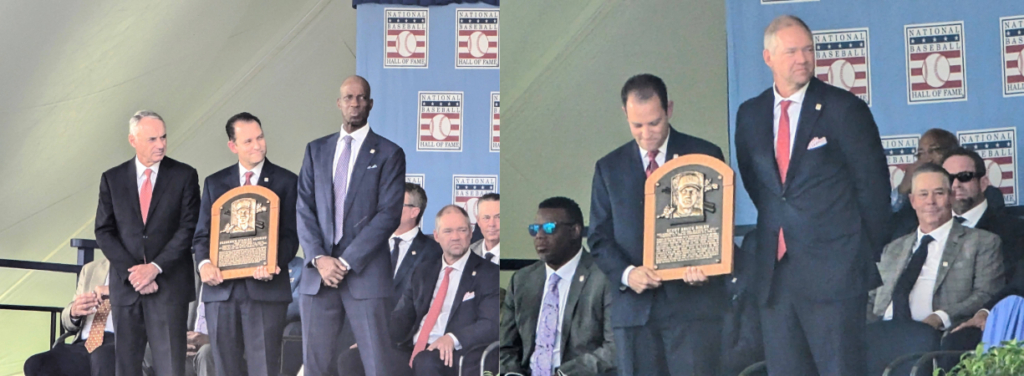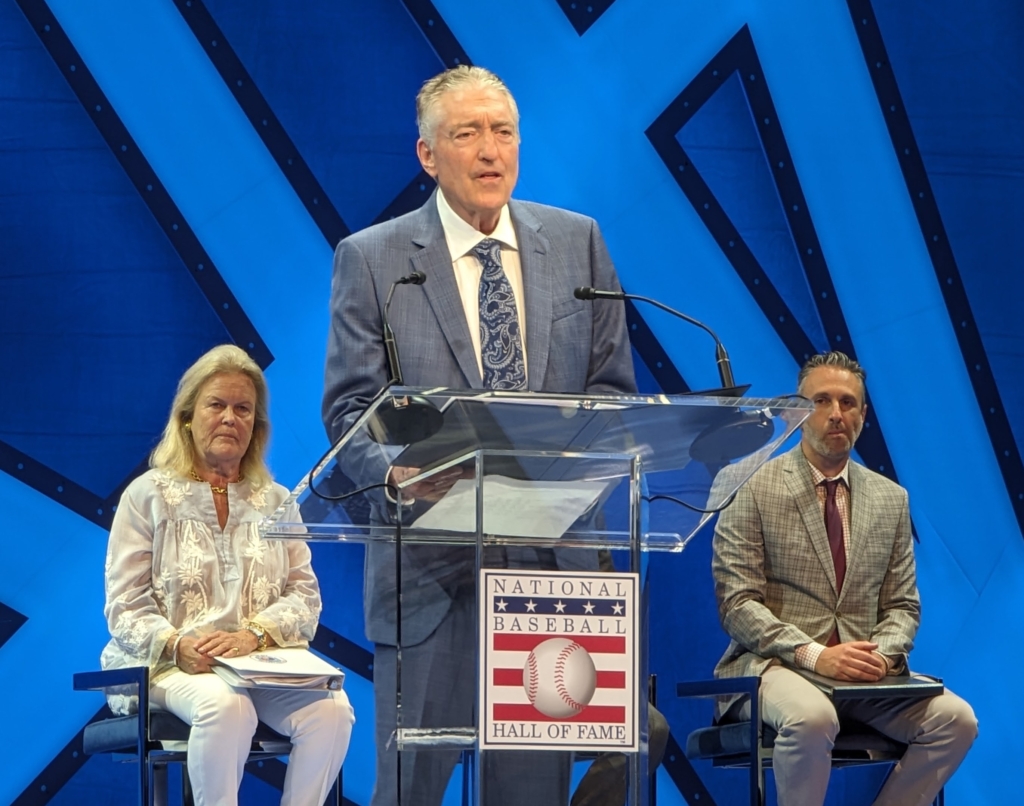The .300/.400/.500 Club: An Elite Hall of Fame Hitting Group
Editor’s note: When this was published in January 2023, Todd Helton was not yet in the Hall of Fame, but he was inducted in 2024.
When it comes to the Baseball Hall of Fame, certain batting “clubs” have — barring disciplinary bans or PED ties — made for automatic induction, either by design or by circumstance. The trivia whizzes know them. 500 Home Runs. 3000 Hits. .300/.400/.500.
Wait… .300/.400/.500?
Yes, the .300/.400/.500 Club. Of the players in major league history with the Baseball Reference-set minimum of 3000 career plate appearances, there are 27 who slashed .300/.400/.500 for their career. Twenty-two are in the Hall of Fame. Of the five who aren’t, one is still active, one did not play long enough, two are on the ballot, and the last got in trouble.
What Is the .300/.400/.500 Club?
There being only 27 to ever do it over the course of a career is a testament to how difficult it is to do in the first place. Batting .300 has long been a benchmark of batting with good contact, and the league batting champions every year tend to have a batting average near the mid-300s. Its calculation is simple — safe hits (of any type) divided by at-bats, rounded to three decimal places. In other words, for every 1000 times that someone puts the ball in play or strikes out, how many times would he get a hit?
On-base percentage looks deeper than batting average, since it counts a walk or being hit by a pitch as a positive, while batting average pretends it never happened. It is a measurement of a batter’s plate discipline. To calculate on-base percentage, take the sum of a batter’s hits, walks, and hit-by-pitches and divide the result by total plate appearances — at-bats, walks, hit-by-pitches, and sacrifice flies. Rounded to three decimal places, it answers the question of how often someone would reach base for every thousand times he steps to the plate. The league leaders tend to be in the low-to-mid-400s every season.
Slugging Percentage
Slugging percentage measures power. It converts each hit into total bases, with a single counting for one, a double for two, a triple for three, and a home run for four. To calculate, take a hitter’s total bases and divide that by at-bats, rounding the answer to three decimal places. In other words, for every thousand times someone puts the ball in play or strikes out, how many bases would he safely touch?
The league leaders tend to be in the high 500s or low 600s. But only nine players in major league history have ever slugged .600 or more during a career, and the active career leader is slugging .587.
Not an Easy Feat
Slashing .300/.400/.500 for so much as one season is tough. Only four players did so in 2022 — Freddie Freeman, Paul Goldschmidt, Aaron Judge, and Yordan Alvarez. In the last five seasons — 2018 through 2022 — it happened 19 times. Four came in 2018, three in 2019, five in the shortened 2020 season, three in 2021, and four in 2022. Only three — Freeman, Juan Soto, and Christian Yelich — did it twice. No one did it more than twice.
Babe Ruth did it in 15 seasons. Stan Musial did so in 14, and Ted Williams in 13. Both Lou Gehrig and Ty Cobb did it in 12. They all slashed .300/.400/.500 in their careers as well. Barry Bonds did it in 11 seasons but did not do it for his career. Neither did Albert Pujols, who made the club in nine seasons. Mickey Mantle did it in eight, but not over the course of his entire career.
The Elite .300/.400/.500 Club
This reporter first heard of this club while discussing the Hall of Fame potential of active players in the twilight of their respective careers. A team executive and former general manager, someone who has been in baseball for decades, mentioned the credentials of one still-active player. One of the first stats he brought up was .300/.400/.500. He said to look at the list of the few people who did it, mentioning they were all either in the Hall of Fame or would be if they hadn’t been suspected of PEDs or gotten into some form of trouble that made him ineligible.
Truer words have ne’er been spoken. Here’s the list, arranged by highest to lowest batting average.
Table of Members
| Player | From | To | G | PA | BA | OBP | SLG | Leagues | HOF? |
| Ty Cobb | 1905 | 1928 | 3034 | 13103 | .366 | .433 | .512 | AL | Yes |
| Oscar Charleston | 1920 | 1941 | 929 | 3962 | .364 | .448 | .614 | NeL | Yes |
| Rogers Hornsby | 1915 | 1937 | 2259 | 9481 | .358 | .434 | .577 | NL, AL | Yes |
| Shoeless Joe Jackson | 1908 | 1920 | 1332 | 5697 | .356 | .423 | .517 | AL | No |
| Jud Wilson | 1923 | 1945 | 901 | 3556 | .352 | .436 | .527 | NeL | Yes |
| Lefty O’Doul | 1919 | 1934 | 970 | 3660 | .349 | .413 | .532 | NL, AL | No |
| Turkey Stearnes | 1923 | 1940 | 986 | 4291 | .349 | .417 | .616 | NeL | Yes |
| Ed Delahanty | 1888 | 1903 | 1837 | 8402 | .346 | .411 | .505 | NL, AL, PL | Yes |
| Tris Speaker | 1907 | 1928 | 2789 | 12020 | .345 | .428 | .500 | AL | Yes |
| Ted Williams | 1939 | 1960 | 2292 | 9792 | .344 | .482 | .634 | AL | Yes |
| Dan Brouthers | 1879 | 1904 | 1676 | 7691 | .342 | .423 | .520 | NL, AA, PL | Yes |
| Babe Ruth | 1914 | 1935 | 2503 | 10626 | .342 | .474 | .690 | NL, AL | Yes |
| Harry Heilmann | 1914 | 1932 | 2147 | 8972 | .342 | .410 | .520 | NL, AL | Yes |
| Lou Gehrig | 1923 | 1939 | 2164 | 9665 | .340 | .447 | .632 | AL | Yes |
| Mule Suttles | 1924 | 1944 | 906 | 3649 | .340 | .410 | .619 | NeL | Yes |
| Stan Musial | 1941 | 1963 | 3026 | 12721 | .331 | .417 | .559 | NL | Yes |
| Willie Wells | 1924 | 1948 | 1039 | 4538 | .330 | .407 | .535 | NeL | Yes |
| Jimmie Foxx | 1925 | 1945 | 2317 | 9677 | .325 | .428 | .609 | NL, AL | Yes |
| Todd Helton | 1997 | 2013 | 2247 | 9453 | .316 | .414 | .539 | NL | No |
| Hank Greenberg | 1930 | 1947 | 1394 | 6098 | .313 | .412 | .605 | NL, AL | Yes |
| Larry Walker | 1989 | 2005 | 1988 | 8030 | .313 | .400 | .565 | NL | Yes |
| Manny Ramírez | 1993 | 2011 | 2302 | 9774 | .312 | .411 | .585 | NL, AL | No |
| Edgar Martinez | 1987 | 2004 | 2055 | 8674 | .312 | .418 | .515 | AL | Yes |
| Mel Ott | 1926 | 1947 | 2730 | 11347 | .304 | .414 | .533 | NL | Yes |
| Chipper Jones | 1993 | 2012 | 2499 | 10614 | .303 | .401 | .529 | NL | Yes |
| Mike Trout | 2011 | 2022 | 1407 | 6159 | .303 | .415 | .587 | AL | No |
| Frank Thomas | 1990 | 2008 | 2322 | 10075 | .301 | .419 | .555 | AL | Yes |
Italics = still active; stats current through end of 2022 season
Sources: Baseball Reference and Stathead.
League Averages, Year by Year
A Truly Elite List
That’s quite a list. Shoeless Joe Jackson isn’t in the Hall because of getting in trouble — he was banned for his role in the Black Sox Scandal of 1919. Lefty O’Doul didn’t play long enough. Yes, he played 11 seasons, but only six were full seasons. The total games played in the other five added up to 151 — three shy of a full season in his era. Manny Ramírez got caught and punished twice after the drug testing rules were codified and likely will not ever get enough votes for induction.
Todd Helton is still on the ballot and very close to reaching induction, and Mike Trout is still active. Trout could retire tomorrow and would be in on the first ballot. Helton, no doubt losing votes due to playing such a large portion of his career in Coors Field, is very close to the 75% threshold. If he doesn’t make it this year, he probably will soon.
Since there are 22,860 players who played in the majors at some point, according to Baseball Reference, for there to be only 27 to reach a certain benchmark in a meaningful stat says something. This becomes more apparent when viewing the graph above and seeing what the league averages were each year. In 2022, .300 was almost 60 points higher than the leaguewide batting averages. .400 was about 90 points higher than the league averages for OBP, and .500 was over 100 points higher than the league averages for slugging.
Considering the names of the people who did it — as well as the people who didn’t — makes membership in the club mean even more. The .300/.400/.500 Club is a special club, one that will only see the cream of the crop add their names to it.
More Hall of Fame Articles
More MLB Articles
Main Photo:
Embed from Getty Images
- Category
-
Hall of Fame






